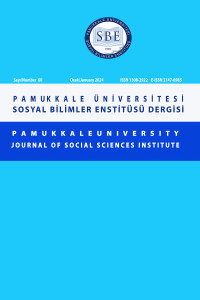Öz
Yamamba is an old hag who lives in the mountain or forest in Japanese creation myth. Yamamba’s most threatening
characteristics are her avenging side and her fearful trait that cause terror mostly among men. Therefore, Yamamba is mostly
known for her anthropophagus qualities that make her a terrifyingly evil woman. Based on this Japanese myth, it is also
possible to see the same Yamamba-topos in Western literature. In Rider Haggard’s King Solomon’s Mines (1885), Gagool the
old hag also has Yamamba-like characteristics that not only does she live in the mountain as an evil force but also threatens
men by causing calamities and producing monstrosities. Therefore, Gagool the old witch in Haggard’s King Solomon’s Mines
can be considered an evil woman having notorious Yamamba traits. In this study, Gagool’s Yamamba-like features will be
scrutinized to discuss her dreadful existence as a devouring witch. It is also within the purpose of this study to illustrate how
Eastern folklore influences Western literature greatly and plays a significant role in constructing a ravenous old woman image
to deconstruct the male authority and power.
Anahtar Kelimeler
Yamamba old witch evil woman fearful woman cannibal woman Gagool King Solomon’s Mines.
Kaynakça
- Copeland, R. (2005). “Mythical Bad Girls: The Corpse, the Crone, and the Snake.” In Bad Girls of Japan, ed. Laura Miller and Jan Bardsley, pp. 15–31. Palgrave.
- Haggard, R. (1994). King Solomon’s Mines. The World’s Best Readings.
- Hori, I. (1968). Folk Religion in Japan: Continuity and Change. University of Chicago Press.
- Hulvey, S.Y. (2000). “Myths and Monsters: The Female Body as the Site for Political Agendas”, ed. Debra Walker King, Body Politics and The Fictional Double, Bloomington & Indianapolis: Indiana University Press, pp.71-88. “Isanusi, n.” Dictionary of South African English. Dictionary Unit for South African English, 2023. Web, http:// https://dsae.co.za/entry/isanusi/e03339
- Komatsu, K. (2000). “Kaisetsu: Tengu to yamauba” [Explanations of tengu and yamauba]. In Kaii no minzokugaku [Folklore of the strange], vol. 5, edited by Komatsu Kazuhiko, 417–434. Tokyo: Kawade Shobō.
- Lerner, G. (1986). The Creation of Patriarchy. Oxford Universisty
- Reider, N. (2005). “Spirited Away: Film of the Fantastic and Evolving Japanese Folk Symbols.” Film Criticism, 29(4), 4-27. Web. http://www.jstor.org/stable/44019178
- ---. (2010). Japanese Demon Lore: Oni from Ancient Times to the Present. Utah State University Press.
- ---. (2021). Mountain Witches: Yamauba. Utah State University Press.
- Sebastian-Jones, M. (2013). “Preface to the Special Issue on the Fairy Tale in Japan.” Marvels & Tales, 27(2), 172- 178. Web. http://digitalcommons.wayne.edu/marvels/vol27/iss2/2
- Viswanathan, M. (1996). “In Pursuit of the Yamamba: The Question of Female Resistance.” In The Woman’s Hand: Gender and Theory in Japanese Women’s Writing, edited by Paul G. Schalow and Janet A. Walker. Stanford University Press, pp. 239–61.
- von Franz, M. L. (1974). Shadow and Evil in Fairy Tales. Spring Publications.
Öz
Japon yaratılış mitolojisinde Yamamba dağda veya ormanda yaşayan yaşlı bir cadıdır. Yamamba’nın en korkutucu özellikleri
arasında, çoğunlukla erkeklerde dehşete sebebiyet veren intikamcı yanı ve korku saçan niteliği gelmektedir. Böylece, Yamamba,
onu korkunç bir şekilde şeytani kadın yapan yamyam özelliğiyle tanınmaktadır. Bahsedilen bu Japon mitine de dayanarak,
Yamamba’ya ait benzer tema ve ögeleri Batı Edebiyatında da görmek mümkündür. Rider Haggard’ın Kral Süleyman’ın Hazineleri
(1885) romanında yaşlı cadı Gagool karakterinde de kendisinin sadece şeytani bir güç olarak dağda yaşaması değil, aynı
zamanda insanlar arasında garabetler saçarak musibetlere sebebiyet vermesi gibi Yamambavari özelliklerin mevcut olduğu
söylenebilir. Böylece, Haggard’ın Kral Süleyman’ın Hazineleri (1885) romanında, yaşlı cadı Gagool karakteri, kötü şöhretli
Yamamba özelliklerine sahip şeytani bir kadın olarak görülebilmektedir. Bu çalışmada, Gagool’un Yamambavari özellikleri,
onun yırtıcı bir cadı olarak korkunç varlığını tartışmak üzere incelenecektir. Bu çalışmanın bir diğer amacı da Doğu halkiyatının
Batı edebiyatına nasıl tesir ettiğini ve vahşi yaşlı kadın tasvirinin erkek otoritesi ve gücünü alaşağı etmede nasıl önemli bir rol
oynadığını göstermektir
Anahtar Kelimeler
Yamamba yaşlı cadı şeytani kadın korkunç kadın yamyam kadın Gagool Kral Süleyman’ın Hazineleri.
Kaynakça
- Copeland, R. (2005). “Mythical Bad Girls: The Corpse, the Crone, and the Snake.” In Bad Girls of Japan, ed. Laura Miller and Jan Bardsley, pp. 15–31. Palgrave.
- Haggard, R. (1994). King Solomon’s Mines. The World’s Best Readings.
- Hori, I. (1968). Folk Religion in Japan: Continuity and Change. University of Chicago Press.
- Hulvey, S.Y. (2000). “Myths and Monsters: The Female Body as the Site for Political Agendas”, ed. Debra Walker King, Body Politics and The Fictional Double, Bloomington & Indianapolis: Indiana University Press, pp.71-88. “Isanusi, n.” Dictionary of South African English. Dictionary Unit for South African English, 2023. Web, http:// https://dsae.co.za/entry/isanusi/e03339
- Komatsu, K. (2000). “Kaisetsu: Tengu to yamauba” [Explanations of tengu and yamauba]. In Kaii no minzokugaku [Folklore of the strange], vol. 5, edited by Komatsu Kazuhiko, 417–434. Tokyo: Kawade Shobō.
- Lerner, G. (1986). The Creation of Patriarchy. Oxford Universisty
- Reider, N. (2005). “Spirited Away: Film of the Fantastic and Evolving Japanese Folk Symbols.” Film Criticism, 29(4), 4-27. Web. http://www.jstor.org/stable/44019178
- ---. (2010). Japanese Demon Lore: Oni from Ancient Times to the Present. Utah State University Press.
- ---. (2021). Mountain Witches: Yamauba. Utah State University Press.
- Sebastian-Jones, M. (2013). “Preface to the Special Issue on the Fairy Tale in Japan.” Marvels & Tales, 27(2), 172- 178. Web. http://digitalcommons.wayne.edu/marvels/vol27/iss2/2
- Viswanathan, M. (1996). “In Pursuit of the Yamamba: The Question of Female Resistance.” In The Woman’s Hand: Gender and Theory in Japanese Women’s Writing, edited by Paul G. Schalow and Janet A. Walker. Stanford University Press, pp. 239–61.
- von Franz, M. L. (1974). Shadow and Evil in Fairy Tales. Spring Publications.
Ayrıntılar
| Birincil Dil | İngilizce |
|---|---|
| Konular | İngiliz ve İrlanda Dili, Edebiyatı ve Kültürü |
| Bölüm | Araştırma Makalesi |
| Yazarlar | |
| Erken Görünüm Tarihi | 17 Ocak 2024 |
| Yayımlanma Tarihi | 17 Ocak 2024 |
| Kabul Tarihi | 15 Ocak 2024 |
| Yayımlandığı Sayı | Yıl 2024 Sayı: 60 |


